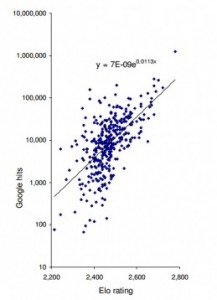Welcome to Purple Pawn, covering games played around the world by billions of people every day.
 In two recent projects researchers made interesting use of games as data sources for their studies.
In two recent projects researchers made interesting use of games as data sources for their studies.
Researchers with the RIKEN Brain Science Institute in Japan studied the brains of Shogi players as part of their investigation in to strategic decision-making. With the moves in Shogi easily classified as either offensive or defensive, the researchers were able to use magnetic resonance imaging to determine that one area towards the front of the brain is responsible for defensive strategies and a different area towards the back is responsible for offensive strategies.
Deeper statistical analysis of the experienced players’ brain activity also revealed that the level of activity was dependent on the quality of the game moves.
In a study of a different sort, researchers at the University of California, Los Angeles used Chess to examine the nature of fame. They compared the Elo rating of 371 Chess players (all grandmasters and international masters born 1901-1943) to the number of hits returned in a Google search of their names—a proxy for a player’s degree of fame. The results indicate that fame increases exponentially with achievement.
No Comments
Sorry, the comment form is closed at this time.
Trending
- Massdrop.com
- Oh the Irony—Illuminati Card Game Continues to Inspire Conspiracy Theorists
- Footprints, an Educational Ecology Game
- Home
- USPS Adds Board Game Flat Rate Box
- Baila, the Estonian Drinking Card Game
- Crystal Caste Wins Dice Patent Suit Against Hasbro
- Mirror Game, Red and Blue
- Are Board Games Dangerous?
- Board Games Based on Hindu Mythology
Archives
Most Popular Articles
- Oh the Irony—Illuminati Card Game Continues to Inspire Conspiracy Theorists
- The 20 Most Valuable Vintage Board Games
- The Truth About Dominoes On Sunday in Alabama
- Sequence Game, and Variants
- USPS Adds Board Game Flat Rate Box
- Baila, the Estonian Drinking Card Game
- The 13 Most Popular Dice Games
- Are Board Games Dangerous?
- Guess Who? The Naked Version
- What Happened to the Jewel Royale Chess Set?
Recent Posts
- Toy Fair 2019—Breaking Games
- Talisman Kingdom Hearts Edition
- Toy Fair 2019—Winning Moves
- Toy Fair 2019—Games Workshop
- Toy Fair 2019—Star Wars Lightsaber Academy
- Toy Fair 2019—Stranger Things Games
- Toy Fair 2019—HABA
- Licensing Roundup
- Game Bandit
- 2018 A Difficult Year For Hasbro But Not For D&D Or MtG
Recent Comments
- on Toy Fair 2019—Winning Moves
- on Game Bandit
- on Second Look—Dungeons & Dragons Waterdeep Dragon Heist
- on Crowdfunding Highlights
- on Beyblade SlingShock
- on Game Bandit
- on Game Bandit
- on Watch This Game!, the Board Game Review Board Game
- on Second Look—Vampire: The Masquerade 5th Edition
- on Palladium Books Loses Robotech IP License, Cancels Five-Year-Overdue Robotech RPG Tactics Kickstarter




